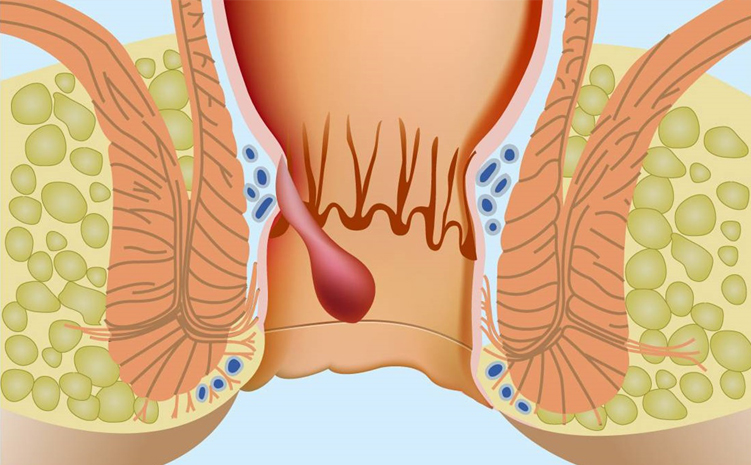Infections in the anus region, defined as the anorectal region, appear as anal abscesses and anal fistulas, which are the chronic form of these abscesses.
When the causes of anal abscesses are examined, the theory that is still accepted today is; dysfunctions in the glands responsible for the secretion of the fluid called mucus (secreted in the anal canal to provide lubrication and facilitate defecation during defecation) called the anal gland, which is located mostly between the inner and outer muscles of the anus, and anal abscesses occur as a result of the fluid accumulation between the muscles after the blockage of their channels and the infection with intense bacteria. We know that these abscess foci primarily direct towards the skin, where there is less resistance, and that anal fistulas form in the anus region, which should not be the normal anatomy.
What is the frequency of Anal Fistula disease in society?
We do not have clear data showing the frequency of anal fistula and anal abscess in society. As mentioned above, since dysfunctional glands in the anal glands are responsible for its formation and since these glands have secretions in approximately 60% of the society, it is possible to say that 60% of the society is at risk.
Anal fistula disease is more common in men (approximately 2-7 times more common in men than in women, according to the difference in publications). This statistical fact reveals the effectiveness of hormones on the anal glands. In other words, it is thought that anal glands (secretory glands) are more sensitive to hormones in patients who develop infection.
Do all Anal Abscesses turn into Anal Fistula?
We know that approximately 50% of anal abscesses turn into anal fistulas. It has been determined that abscesses developing under the age of 40 have a higher probability of recurrence and a higher rate of turning into anal fistulas compared to the population over the age of 40. The risk is also higher in the diabetic patient group.
What diseases can cause anal fistula?
Anal fistulas may be the first symptom of some diseases. Tuberculosis, Pelvic inflammatory diseases, Pelvic malignancies (cancers), Inflammatory bowel diseases (Crohn's), AIDS and Hematological diseases (neutropenic patients, leukemia).
What are the risk factors for the development of anal abscess?
There are various risk factors for the development of infection. These include; sclerotherapy procedure for hemorrhoids (in the treatment of piles), band ligation (a method of tying a rubber band for hemorrhoids), hard puncture particles in foods, trauma due to an enema catheter during bowel cleansing, birth trauma, thrombosed external hemorrhoids, radiotherapy to the pelvis, cancer and inflammatory bowel diseases.
What is the clinical picture of a patient with anal abscess?
In anal abscesses, the patient presents with complaints of pain in the anus, which increases especially when sitting or defecating, that is, when defecating. There is a sensitive, painful, reddened hardness near the anal area. Patients may experience weakness, low body resistance, sweating and fever.
Depending on the localization of the abscess around the anus, some patients may experience problems urinating. In some deep-seated anal abscesses, there may be a feeling called tenesmus, where the patient still cannot fully relax despite defecating.
What are the clinical findings of Anal Fistula Patients?
Anal fistula, which is a chronic form of infections defined in the anal region, can cause anal discharge that will significantly affect the quality of life of patients as their presenting symptoms. These discharges can appear in the form of soiling and staining of underwear. The frequency, amount and nature of the discharge can change from time to time. Discharge may not always be present in anal fistulas. In cases where the discharge is excessive, redness, irritation and itching can be seen on the skin around the anus. Pain and bleeding can be seen in the anus during or after defecation. Palpable hardness and mass lesions can be seen at the external mouth of the fistula.
How is Anal Fistula diagnosed?
How is Anal Fistula diagnosed? ?The diagnosis of Anal Fistula disease can be made clinically. The diagnosis will be confirmed with imaging methods and the relationship of the fistula tract with the internal and external muscle groups in the anus region will be revealed. In previous years, the aim of these diagnostic methods was to reveal the path with a graphic drawn with a contrast material given from the external mouth of the fistula, called fistulography. Today, contrast-enhanced Pelvic MRI and Endoanal USG are used for this purpose.
Contrast-enhanced Pelvic MRI can reveal the relationship of the fistula tract with the anal muscles, namely the sphincter complex, in the diagnosis of anal fistula and in three dimensions. Although it is not necessary for every anal fistula diagnosis, the information to be given by an experienced Radiologist is extremely important. Pelvic MRI is also meaningful for the evaluation of the integrity of the anal muscles, especially in luxating cases.
Endoanal USG also provides important information in experienced hands. Endoanal USG, which can be performed ultrasonically even in the office environment, can provide information about the fistula tract, simultaneous anal abscess, and the integrity of the anal muscles.
How is Anal Abscess and Anal Fistula treated?
The aim of the treatment of perianal fistula disease is, in principle, to eliminate the fistula tract, prevent recurrence and preserve anal functions.
It is extremely important that the treatment of acute anal abscesses and chronic anal fistulas, which are infectious diseases of the perianal region, is performed by physicians with clinical experience.
It is important that the diagnosis of the patient presenting with an abscess in the anal region is made quickly and that drainage (emptying the abscess), which is the unchanging and indisputable rule of surgery in terms of abscess, is performed. An important point that should be emphasized here is that it is vital that drainage is performed as soon as possible in patients diagnosed with diabetes and those with a dominant immune system (cancer patients receiving chemotherapy, neutropenic patients).
It is important for the continuation of the disease that drainage, which is the first and most important step in the treatment of anal abscess, is performed by an experienced proctologist (anal region diseases specialist). The abscess focus should be drained in an environment where the patient is comfortable, preferably under appropriate anesthesia, in an appropriate position, in a hygienic environment and from the correct localization. Draining from the wrong location can cause more complex fistulas to form and make treatment more difficult.
Depending on the condition of the abscess; it is also important that the underlying anal fistula can be treated simultaneously by an experienced physician.
The treatment of anal fistula disease is surgery. Again, fistula treatment should be performed by experienced surgeons in this regard. Only in this way can the chance of success be increased and the risk of complications be reduced. Determining the appropriate surgical method for the patient in the surgical treatment of anal fistula also requires experience.
How to decide on the surgical option for Anal Fistula?
In the treatment of anal fistula; the physician's experience is required to reveal surgical options that are suitable for the patient, have a higher chance of success and a lower risk of complications.
It is extremely important for the physician to take a detailed history of the patient, determine all previous surgical interventions performed on the patient, question the history of birth traumas and episiotomy, especially in female patients, and question possible additional diseases that may underlie the disease.
Before the surgery, it is extremely important to determine the external opening of the fistula, if any, to determine the localization of the possible internal opening, to evaluate the muscle groups, and to evaluate the anus tone in experienced hands. It should not be forgotten that a simultaneous abscess should be revealed. The quality of the discharge coming from the fistula tract is important in choosing the surgical treatment option to be performed. For example, the option of treating a fistula with purulent discharge from the fistula mouth with laser should not be considered.
The patient should be questioned whether there is gas or stool leakage and anal contamination, and this information should be recorded. In some patients, anal manometry and anal canal pressure measurements should be taken and archived, it is important.
In some patients, the interpretation of the Contrast Pelvic MRI to be taken before the surgery by an experienced radiologist will reveal the three-dimensional relationship of the fistula with the anal muscles. The clinical and examination findings to be given to the radiologist in the Pelvic MRI will provide information on the localization of the external and internal mouth of the fistula, the relationship and course of the fistula tract with the anal muscles, and the condition of the anal muscles. All this information will help the surgeon in deciding on the most appropriate surgical option for the patient.
What are the surgical options for Anal Fistula Disease?
Having discussed how to choose the surgical option in the treatment of anal fistula, let us try to explain the surgical options one by one.
A. Fistulotomy:
In this option, the goal is to expose the fistula tract by opening the external and internal opening of the fistula. It is still the most common surgical option in the treatment of anal fistula in pets today. After opening the fistula tract, it is important to curette and remove the tissue that lines the inner layer of the fistula and is the focus of infection. It is important that opening the fistula does not pose a risk to the patient in terms of incontinence.
Of course, the decision on this issue rests with the experienced physician. Although fistulotomy is the most commonly used type of surgery for perianal fistulas today, there is a large group of patients in whom this surgical option cannot be performed. The fistula tract involves most of the internal and external anus muscles, in high, complicated structures, in recurrent fistulas where there is also anal continence disorder or where a small muscle damage can pose a high risk (lateral fistulas). of the vagina in women, female patients with muscle damage after birth trauma, previous. This surgical option should not be preferred in patients after anal surgery, elderly people and patients with low anal muscle tone and low resting pressure.
The important point that the surgeon should carefully evaluate is to correctly decide which patient and/or after which limit this procedure should not be performed. For this, it is important to evaluate perianal fistula cases very well before surgery, to obtain a fistula map, and to perform surgical intervention only after these preparations are completed.
The localization of the fistula tract in the anus region is important in terms of wound healing. Fistulotomies performed in locations where blood flow in the anus channel is less may result in poor wound healing called keyhole deformity.
B. Fistulectomy:
It is the process of removing the fistula tract by stripping it from the surrounding tissues. How fistulotomy and fistulectomy are performed is shown schematically. Here, it is seen that more tissue is removed in fistulectomy. It is riskier in terms of muscle damage in the surrounding tissues and the risk of incontinence is higher. The question that undoubtedly comes to mind here is why this surgery is an option. In patients with a seton placed in the fistula tract, fistulectomy can be used as an option in areas where the outer section of the external muscles is safer. This is called "coring out fistulectomy". Afterwards, the open area will be left for wound healing.
C. Anal Fistula Seton application:
Seton application in anal fistula treatment has been used for many years. It is still an important treatment method. It is a method performed by revealing the inner and outer mouths of the fistula and then the fistula path, then the tissues lining the inner part of the fistula are curetted and removed, and then the materials called Seton are fixed to the passages through this path.
Seton application can be placed as loose and tight seton. The surgeon should decide what the characteristics of the Seton material to be placed should be and which one to prefer. Again, it requires experience to choose which seton to prefer, tight or loose.
There are two important purposes of placing a seton. First, it is aimed to remove the presence of infection in the environment with the drainage made by the seton, and secondly, it is aimed to prevent incontinence by preventing the separation of the muscles with the hard tissue called fibrosis that the muscle incision will make in the surrounding tissues.
The choice of loose or tight seton, whether the seton should be tightened over time, and how long it should remain require experience.
D. Fibrin Adhesive and Biological Plug Applications
Biological materials that accelerate the closure of the fistula without cutting the anal sphincter muscles have also been used as alternatives. These include the injection of fibrin glue into the fistula tract or the placement of a plug prepared from the small intestinal submucosa (SIS).
The fistula tract (path) is intended to be closed with these two materials.
E.LIFT Surgery
One of the current methods used in complex fistula treatment is LIFT (Ligation of the Intersphincteric Tract) surgery. The main logic of the surgery is to remove the anal glands located between the internal and external muscles of the anus, called the intersphincteric distance, which is the main focus in the emergence of anal abscesses and fistulas, and to eliminate the connection between the anal canal and the external mouth by connecting the internal and external mouths of the fistula tract.
It is a surgical option with a high chance of success and a low risk of complications when performed by experienced physicians.
F. Advancement Flap Surgeries
The success of Flap shifting techniques in the treatment of Perianal Fistulas is related to the selection of the appropriate patient and the experience of the physician who will perform the application in this regard. This technique should not be performed in some patient groups. The aim of the surgery is to ensure that an island lining the inner surface of the anal canal and on the skin side is released and the inner mouth of the fistula is closed.
•Presence of proctitis (Crohn's disease) and high-dose steroid use
•Presence of undrained abscess foci
•Presence of fistula history of less than 4 weeks
•Presence of persistent secondary fistula tracts
•Perianal fistulas due to cancer or radiation
•A defect in the anal muscles due to previous surgery
What is a Horseshoe Fistula?
Horseshoe fistula is the most complete fistula among anal fistula patients.
Horseshoe abscess and fistulas, which should be discussed as a separate title among perianal fistula diseases, are difficult to treat. It is a fistula type that requires experience, has a low chance of success and carries a risk of complications.
They are horseshoe-shaped abscesses that surround the anus from the anatomical spaces around the anus.
Horseshoe fistula surgery is a surgery that should be performed by experienced and experienced physicians in this field. The surgeon who deals with proctology and the patient should be patient during the treatment process.
The patient should be followed closely. Revisions should be made without delay when necessary.
There is always a risk of gas and fecal incontinence in such serious fistulas. The surgeon's experience, the selection of the ideal technique for the patient, diabetes, ischemic diseases, smoking, and not having had fistula surgery before are the most important factors affecting the success of the treatment.
I have been diagnosed with Anal Fistula, what happens if I do not undergo surgery?
The treatment of anal fistula is surgical. If surgery is not performed, the patient will first experience discharge, itching, and hygiene problems that will reduce their quality of life. In addition, frequent abscess attacks and each abscess attack may cause new fistulas that can reach new areas. Therefore, treatment may be more difficult over time and may result in higher complication risks.
What are the risks of Anal Fistula surgery?
The aim of anal fistula surgery is to eliminate the fistula. Of course, while providing this, it is extremely important to maintain continence (ability to hold gas and stool). Anal fistula surgery is an operation that requires experience, and it is important that it is performed by experienced proctologists.



